
Why We Use Fins
I am really fond of being in the water, I love to swim, to snorkel and to dive. I swim a lot in pools and in the sea and would say I’m a fairly competent swimmer, however, have you ever tried to swim with a pair of jeans and a T-shirt on? It’s ridiculously difficult because the clothes are heavy and cause drag. Imagine how much weight and drag a full BCD, tank and exposure suit creates. To try to breaststroke with all that equipment on would be almost futile, especially if there was even a mild current. So, naturally, we compensate for the equipment we wear by using other pieces of gear. In this case, we use fins.
Essentially fins are just artificial extensions of our feet that allow our legs to be used to their full potential underwater. Our legs are our usual mode of transport on land, why wouldn’t they be when in the water? The basic principal of finning is that we use our legs to push the fins, the fins push the water and, in turn, we are propelled forward. It seems fairly straightforward, but there are many factors at play when a fin moves through the water, and there are many ways to make it work.
When you come to choosing your fins, you have a range of options and styles to consider. I hope to enlighten you to some of the main features available on modern fins, and introduce you to some of the styles on offer.
Who Are These Fins For?
Before you even walk into a dive equipment supplier, you need to have an idea of what you want your fins for. Throughout this article I will discuss three different scenarios; the casual snorkeler/diver (probably buying the fins for holiday use), the midrange diver (these will be a mainstay fin for an amateur diver) and the professional/Tec diver (who will use them frequently, requires performance and reliability).
Open Heel or Full Foot
First off, we must look at the difference between a full foot pocket, and an open heel with a strap. These terms describe the method in which your foot is integrated with the fin blade. Essentially, a full foot pocket fin is simply a slipper style sock that is directly attached to the blade. The wearer simply inserts their bare foot (or a foot with a very thin sock) into the foot pocket and wears them like a pair of shoes.
An open heel fin is a blade with a half foot pocket and a heel strap. The foot pocket is more rigid than the slipper-like full foot pocket, it is also much larger because it is designed to accommodate neoprene dive boots. The idea is that the wearer puts on the boots, and then puts the boots into the fin.
Full Foot Pocket Fins
Full foot fins are used for anything from light snorkelling right up to mid range applications. The holiday diver and the amateur diver would probably choose these fins.
- They tend to be used in warm waters because they provide little insulation for the feet, especially for the toes, which are usually exposed to the water.
- Full foot fins are great for surface swimming, especially face down snorkelling. This is because they are lighter in weight than open heel fins.
- They used to be considered the fastest fins on the market because of the ergonomics of the pocket, however this has somewhat changed in favour of the open heel fins in recent years due to modern materials and technologies.
- For traveling they are much more convenient because they are lighter and you do not need to also carry a pair of dive boots.
- It is common for divers to get bad blisters and rubbing related injuries from full foot fins that don’t fit well, therefore it is very important that you buy fins that fit close to the skin, but don’t pinch or rub.
- If you wear full foot fins then you must walk in your bare feet until you are ready to put them on, this can be a hassle or dangerous on a boat or a rocky shore.
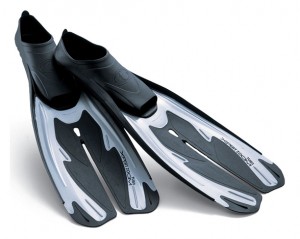
- Full Foot Fins Are Lightweight And Ideal For Snorkelling
Open Heel Fins
Open heel fins can be used from snorkelling right the way through to heavy duty commercial diving or military applications, though the style tends to be found from mid range up to professional. Our hobby diver and our Tec diver would likely choose this type of fin (especially if they were going to go cold water diving).
- Open heel fins are worn with boots, this means that a diver can fully insulate his foot from the cold water. Open heel is the only option for a dry suit diver.
- Open heel fins make entering the water from the shore easier because the diver’s feet are protected by the boots.
- Open heel fins, by virtue of them being stiffer than full foot fins, are associated with power and acceleration. This makes them ideal for professionals who require these fins to propel them in heavy gear and possibly even dragging students, tools or camera gear around.
- Because open fins can be used for any diving application, but full foot fins are limited to light weight, warm water dives there is a trend amongst manufacturers to concentrate their research and development budget on open heel fins.
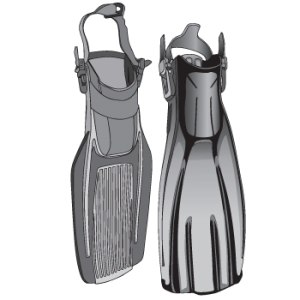
- Open Heel Fins Have A Large Strap At The Rear That Holds The Fin In Place
Blade Style
Obviously having either a full foot fin, or an open heel fin would be pretty much irrelevant unless you had something attached to it on the other end. Broadly speaking these are called the blades of the fin, they are what displace the water and generates the thrust.
There are many different designs of blade, most of which are heralded as the most efficient, controllable and fast style of blade. Having done much research into this topic I am convinced that the most effective style of blade is the one that integrates with the diver the best. Not all divers want the same thing from their fins, meaning that everyone finds different attributes of the blade to be important or redundant. There are a large range of technologies on the market, some look conventional and some look ridiculous, but I’m quite sure that they all have their fan clubs that would support them in their application for best fin ever made.
Paddle Fin
The paddle style is the original form of fin. The concept goes back as far as Leonardo Da Vinci (obviously! I think it’s fair to say that he probably had a wooden version of the Internet that ran on rum and gerbils – he thought of everything else!) The first prototypes that were commercially available (made for the Frogmen during the second World War) were simply rubber planks that were much more effective than bare manpower alone, but the designs were crude and simplistic.
The paddle fin still exists today, though it is now made from a multitude of different materials for each section which gives it the optimum strength at the appropriate places, allows the blade to flex sufficiently to force the water backwards, ensures the blade is stiff enough to generate thrust and to cut the overall weight of the fin. The modern paddle fin is also decorated by a range of different shaped holes, vents, ribs and channels which are used to reduce drag and force the water rearwards, rather than letting it spill over the sides.
- Almost all cheap fins will use the paddle design because it is well known, simple to construct and the simple design is not threatening to a novice fin user. They appear familiar.
- Paddle fins can be made to be efficient, though they are loosing their market share to new, more novel designs like the split fin and the wing.
- There is an evolution of the paddle fin that has much longer blades (1.5x standard dive length) and are constructed from more flexible materials which are used for freediving. They are very specialized fins that are impractical for anything other than freediving. They generate the massive thrust necessary to get the freedivers as deep as they can achieve with as little effort as possible.
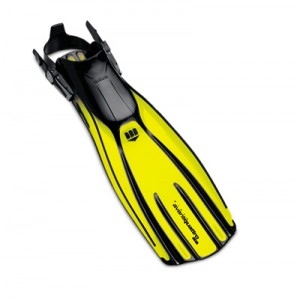
- Paddle Fins Are A Familiar Sight To Even The Most Novice Diver
Jet Fins
Jet Fins are not really all that different from paddle fins, they are just a family of paddle fins that have found their own specific market. Jets have been going since the mid sixties, which coincides with the initial take-up of recreational diving. They tend to be shorter and broader than their paddle counterparts, stiffer, most robust and have large vents at the end of the foot pocket. They are iconic and are still amongst the most well loved fins available on the market today. To find out more please see my in-depth feature on this most famous of dive institutions (just click “see more from this author” and you will see my Jet Fins article).
Jets tend to be used by professional divers, Tec boys and the old guard of hobby divers. They are a poor choice for the novice diver who wants to snorkel and travel with them because of their bulk and weight.
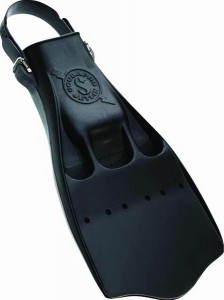
Old School And Classic, Jet Fins Will Be Around Forever
Split Fin
Split Fins are very similar to standard paddle fins, they are usually made from similar materials, they are often around the same length and width as a standard paddle and they even share the same profile, with one substantial difference – they have a large split that runs from tip to almost as high as the foot pocket. This split is designed to emulate the shapes found in nature, copying the motions of fish fins. The design philosophy suggests that having two conjoined paddles on each foot will require less force to push through the water, but will provide a great thrust for little effort.
There is no doubt that split fins are fast and efficient, though it is a common statement from divers who are unfamiliar with them to complain that they are too flexible and have a tendency to “flop” around under excessive strain. I believe this is simply a technique issue that is overcome by practice with the fin, once the diver is comfortable with the fin’s peculiar feedback the comments are usually very favourable.
A positive feature of the split fin design is that they tend to be light, which makes them great for travel and for snorkelling, but they are also efficient which allows them to be useful for professional divers and Tec diving…they can be classed as an all-rounder fin; good for any level of diver.
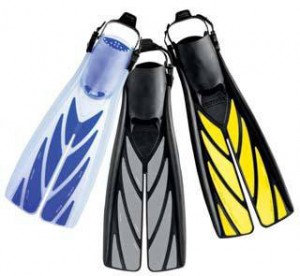
Quickly Becoming A Classic…
Force Fin
Mention Force Fins to any seasoned dive veteran and he will likely gush about the one time he saw a pair of Force Fins in action, that one time back in the day. He will probably also over exaggerate their abilities, his memories being clouded and rose-tinted. He might have a friend-of-a-friend who tested a pair for a while and said they were the best fins he’d ever used. Usually, any contact anyone has with Force Fins is short and often by proxy which has led to a proliferation of urban legends and overblown stories about these fins.
Force Fins have caused this big stir in the diving world for two distinct reasons that are completely interrelated. First, the fins look weird. There is no getting round the fact that they look plain ridiculous, even when worn by the most hardened commercial diver. They are short fins that have a strap that covers the top of the foot. The toes and heel are exposed, though the heel has a bungee strap to hold the fin in place. This pocket design, along with the blade being curved up at the end into a whale tail is said to harness the strongest muscles in the leg and utilises the technologies found in nature to propel the diver at great speed with little effort. The second reason they have caused such a big splash in the diver community is that this ridiculous looking design of fin actually succeeds in living up to its preposterous image and works, which is rare in diving products!
I have used a pair of Force Fins, but only for a short while, though I can say that the myths and the legends are mostly true. They are excellent fins, and their design is really intuitive to learn and use. They certainly provide ample thrust for minimal effort and they are ideal for travel because they are both short and light. Do I have criticisms? Not really, but then I only had a short exposure to these odd looking fins so I didn’t have the chance to see if they rubbed or caused peculiar cramps. It appears that you must develop a very different finning style to make these fins work to their best; a short and rapid flutter kick is more effective than a long power stroke. This might be a negative point for the frog kickers among us who like long power kicks rather than light and fast motions.
Force Fins are surprisingly versatile in their applications; they could be recommended to any level of diver or snorkeler. Our theoretical novice diver could own the same pair as our hardcore Tec diver. Though they’d both have to be making good money as a good pair of Force Fins can set you back as much as $700USD!
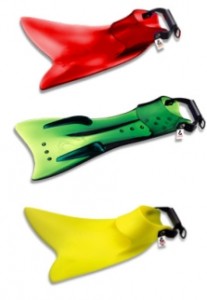
Whacky Looking But Amazingly Effective…
Wing-Blade
So, surely we’ve looked at every type of fin shape imaginable right? There are only so many shapes a plank can be? Well, Scubapro thought not, and built the Seawing Nova. This fin is neither a paddle fin, nor a split fin, or any existing class of fin that exists today. So, I had to give it its own category, especially being as it looks likely that it might spawn its own entire subdivision of fin technology.
The wing design philosophy suggests that a paddle fin is effective but has too much material that is redundant when kicking. Scubapro found that all the material on the paddle that was nearest the foot pocket was causing more drag than it was producing thrust, so SP cut it out. They simply removed most of the paddle next to the pocket and left the rest of the paddle suspended on two flexible supports. This gives the appearance of a foot pocket with a wing attached, hence the fin’s name: The Seawing Nova.
The effect of this drastic material deletion is a fin that is exceptionally light, both in weight and in feedback from kicks, and is surprisingly fast. The paddle-wing is on very flexible struts that give a similar “floppy” feel to split fins, but the actual speed that a diver achieves from the fins is remarkable.
Wing fins are similar to split fins in that they are astonishingly light weight (being as SP chopped most of the fin off!) and are therefore great for travellers and snorkelers, but they are also effective in more serious applications. Though I’d be surprised if many commercial divers opted to use such a revolutionary design in their work – the integrity of the struts are simply not anecdotally tested enough for many pros to trust.
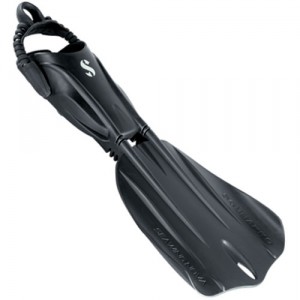
The Shape Of Fins To Come?
Mono Fins
I thought I’d finish my blade-rundown on a freaky style of fin that is highly specialised and not especially popular but interesting nonetheless. Mono fins are simply two paddle fins fused together, with both foot pockets being joined side-by-side. The effect of this fin design is to create something like a mermaid’s tail for the diver.
This fin shape is only really employed by freedivers who like to use a dolphin style of finning motion, where the whole body is involved in the propulsion of the diver. The fin is normally very wide and very stiff, the shock absorption is not created by the flex in the blade, but in the bend of the knee and hip. They are very fast fins but obviously require practice to make use of their unique attributes. They are not very easy to manoeuvre in either, making them almost unused in SCUBA diving.
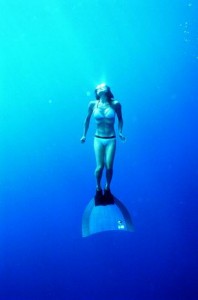
Mono Fins – Turning People Into Mermaids Since 1965!
Material
The material in a dive fin has to fulfil a large number of mutually exclusive criteria, some materials manage to achieve more of them than others. In most high end modern fins there is are number of composite materials at different sections of the fin that optimise overall performance. A fin requires the following attributes from its materials:
- Rigidity – A fin needs to be rigid enough to convey all the force of the kick backwards, to generate thrust. Stiff materials such as plastic and strong rubber composites achieve this. Carbon fibre is often being employed for its rigidity in top-end fins.
- Weight – A fin must be light weight for both traveling and so it doesn’t adversely affect the diver’s buoyancy. A light fin is a logistically viable fin.
- Flexibility – Just as the fin must be stiff to transfer the diver’s kick energy backwards, a fin must also flex enough to provide a flick in the water and to avoid snapping a brittle blade. This is where cheap plastics fail as they are often too brittle and snap. Rubber composites and lightweight synthetic rubbers are much more flexible.
- Visibility – Not always a concern, but most divers like a bright fin to aid their visibility under the water, rubber is poor for this, as is carbon fibre, but plastics can be made in any luminous colour.
- Integrity – A big importance for many divers is that they need to know their fins will last a lifetime, this means that they are tough enough to take knocks during transport and use, but they also need to be corrosion resistant and protected from sun damage. A poor rubber will perish but high quality rubber composites and plastics are very durable.
Final Thoughts
It is worth really researching your fins before you opt to spurge a big wedge of cash on them. They are integral pieces of dive equipment that meld with you as you dive. They must become extensions of your feet and legs for you to get the most from your dive so it is worth taking extra time to pick the best pair for your needs. I strongly recommend you convince your friends to let you try their fins as there is no substitute for getting wet with a pair of planks and getting to know them on an epic dive. Either way I wish you all the best and would love to hear your thoughts on your experiences with fins in the comments section below, be they positive or negative!
Happy bubbles!